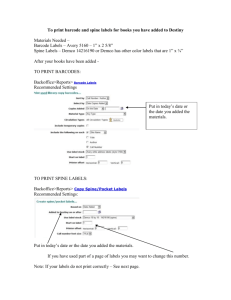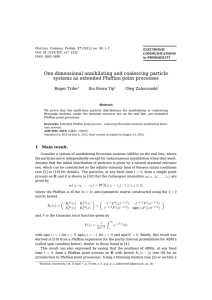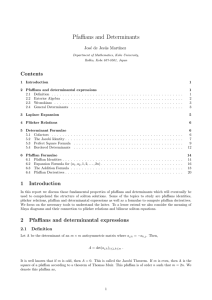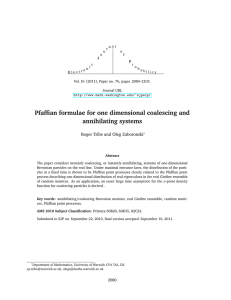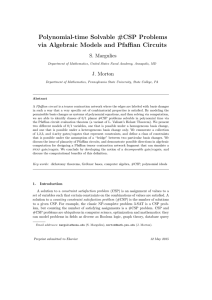Scattering of Massless Particles in Arbitrary Dimension: Soft Limits
advertisement
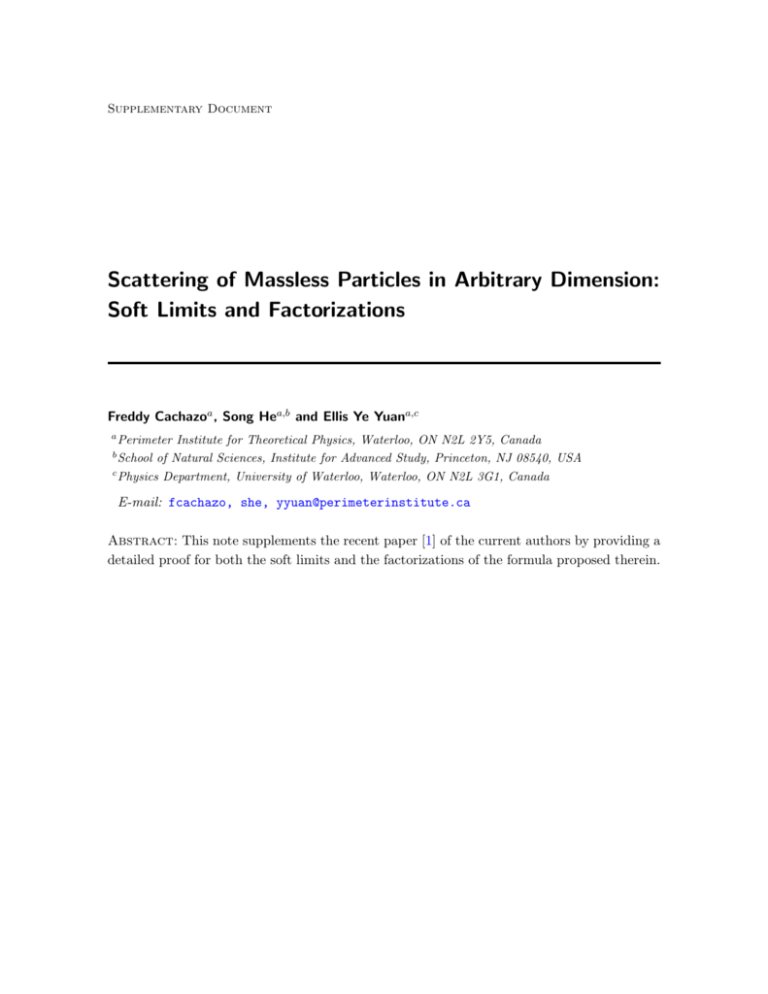
Supplementary Document
Scattering of Massless Particles in Arbitrary Dimension:
Soft Limits and Factorizations
Freddy Cachazoa , Song Hea,b and Ellis Ye Yuana,c
a
Perimeter Institute for Theoretical Physics, Waterloo, ON N2L 2Y5, Canada
School of Natural Sciences, Institute for Advanced Study, Princeton, NJ 08540, USA
c
Physics Department, University of Waterloo, Waterloo, ON N2L 3G1, Canada
b
E-mail: fcachazo, she, yyuan@perimeterinstitute.ca
Abstract: This note supplements the recent paper [1] of the current authors by providing a
detailed proof for both the soft limits and the factorizations of the formula proposed therein.
Contents
1 Soft Limit
1
2 Factorization
3
We study in turn the soft limit and factorizations on physical poles of the formulas for
Yang-Mills and gravity tree-level S-matrices in any dimensions,
Z
Y X ka · kb
1
d nσ
0
An =
δ(
) Pf 0 Ψ(k, , σ).
vol SL(2, C)
σ12 · · · σn1 a
σab
b6=a
Z
(0.1)
Y
X
ka · kb
1
n
0
0
0
d σ
δ(
) Pf Ψ(k, , σ) Pf Ψ(k, ˜, σ).
Mn =
vol SL(2, C)
σab
a
b6=a
To simplify notations, we also denote Ψ̃ = Ψ(k, ˜, σ). Both formulas can be written in a form
where all the integrals have been performed
An =
Pf 0 Ψ(k, , σ)
1
σ12 · · · σn1
det0 Φ
(0.2)
Pf 0 Ψ(k, , σ) Pf 0 Ψ(k, ˜, σ)
.
det0 Φ
(0.3)
X
{σ}∈ solutions
and
Mn =
X
{σ}∈ solutions
The definition of the matrix Ψ and the reduced Pfaffian as well as its consistency (i.e. gauge
invariance and permutation invariance) have been discussed in detail in [1].
1
Soft Limit
As discussed in detail in [2], when we take the soft limit kn → 0, kn ≡ εk̂n → 0, to leading
order in ε, n − 1 of the scattering equations become identical to those of a system with n − 1
particles. The last equation
X kn · kb
=0
(1.1)
σn − σb
b6=n
becomes a polynomial for σn of degree n − 3 (due to momentum conservation). With the
choice that σn unfixed and the nth equation included, the measure and delta functions split
into the (n−1)-particle part and the part for the nth particle,
n
n−1
n−1
Y
X ka · kb
Y X ka · kb
X kn · ka
d nσ
d n−1 σ
0
0
δ(
)→
δ(
)dσn δ(
).
vol SL(2, C)
σa,b
vol SL(2, C)
σa,b
σn,a
a=1
a=1
b6=a
–1–
b6=a
a=1
(1.2)
The kinematic-dependence of the integrand of Yang-Mills/gravity amplitude is encoded
in the reduced Pfaffian Pf 0 Ψ, and only the nth column and row of Ψ depend on kn under
consideration. The Pfaffian of a 2m × 2m matrix E satisfies a recursion relation of the form
(ignoring the overall sign)
2m
X
pq
Pf(E) =
(−1)q epq Pf(Epq
).
(1.3)
q=1
Using this formula to expand PfΨij
ij (assuming i 6= n, j 6= n) setting p = n, and note that Ψna
P
n ·ka
for a = 1, . . . , 2n−1 are proportional to kn (except Ψnn = 0) while Ψn,2n = n−1
a=1 σn,a , thus
one finds that in the soft limit only one term contributes and gives
PfΨij
ij
→
ijn(2n)
Cnn PfΨijn(2n)
=
n−1
X
a=1
Q
n · ka b6=a σn,b
Qn
PfΨn−1 ij
ij ,
c=1 σn,c
(1.4)
ijn(2n)
where in the second equality one uses the nice fact that PfΨijn(2n) is independent of kn and
n and gives rise to Pf 0 Ψn−1 , i.e., the reduced Pfaffian for n − 1 particles. For Yang-Mills
amplitudes, using the explicit formula (0.2) in the soft limit one finds
(n−4)! I
An →
X
Γ
i=1
P
dσn P
(i)
b6=a σn,b
Q
(i)
ka b6=a σn,b
a6=n n
· ka
a6=n kn
·
(i)
Q
σn−1,1
(i)
(i)
(i)
Pf 0 Ψn−1
1
(i)
(i)
(i)
σn−1,n σn,1 σ1,2 · · · σn−1,1 det0 Φn−1
,
(1.5)
(i)
where the sum is over (n−4)! solutions of the equations for n−1 particles and all σa ’s with
a ∈ {1, 2, . . . , n − 1} are taken to be evaluated on the ith solution. Since σa ’s are taken to be
complex numbers in our formulas, the delta functions imposing the scattering equations are
in fact poles and all our integrals are contour integrals; here the contour Γ for the integral
over σn is defined to encircle the n − 3 zeroes of the first factor in the denominator. Similarly
for gravity amplitudes using (0.3) one finds
(n−4)! I
Mn →
X
i=1
Γ
P
dσn P
a6=n n
(i)
b6=a σn,b
Q
(i)
ka b6=a σn,b
· ka
a6=n kn ·
Q
P
(i)
b6=a σn,b
Qn−1 (i)
c=1 σn,c
a6=n n
· ka
Q
(i)
(i)
Pf 0 Ψn−1 Pf 0 Ψ̃n−1
(i)
det0 Φn−1
.
(1.6)
Let us study the pole at infinity: as σn → ∞, the first factor goes like a constant since
the polynomial in the numerator is also of degree n−3, and in both cases the second factor
goes like 1/σn2 . Hence for both Yang-Mills and gravity there is no contribution at infinity,
and using residue theorems the contour can be deformed to enclose the poles of the second
factor in both cases. For Yang-Mills, there are only two poles at σn = σn−1 and at σn = σ1 ,
while for gravity there are n−1 poles at σn = σc for c = 1, . . . , n−1.
In both cases, the residue at σn = σc is trivial to compute, as only a single term with
a = c from the sum in the numerator (for gravity a = c in both sums) and the one with
a = c from that in the denominator contribute. The product of the first two factors becomes
–2–
independent of i hence can be pulled out of the sum, and by summing over the solutions one
obtains amplitudes with n−1 particles
An →
n · k1
n · kn−1
+
kn · kn−1 kn · k1
An−1 ,
Mn →
n−1
X
a=1
n · ka ˜n · ka
Mn−1 ,
kn · ka
(1.7)
which is the correct soft behavior [3, 4].
2
Factorization
For the purpose of showing that (0.1) has the correct behavior in any physical factorization
channel, it is sufficient to have a look at only the kinematics singularity defined by
(k1 + k2 + · · · + knL )2 −→ 0,
(2.1)
with 2 ≤ nL ≤ n − 2, and we denote L = {1, . . . , nL } and R as its complenent set, with
nR = n − nL . We will only focus on the factorization of Yang-Mills amplitudes An . That of
the gravity amplitudes follows straightforwardly from the results here.
From the study of scattering equations in [2], we have known that upon such singularity,
the scattering equations will produce (nL − 2)! × (nR − 2)! singular solutions. When we
choose to fix {σ1 , σ2 , σn } for the SL(2, C) redundancy, it is convenient to do the following
re-definitions of the σ’s in order to see the singularity explicitly
(
s
, a∈L
σa = uv a
,
(2.2)
a
s , a∈R
where we take s as a variable to be integrated over, while {u1 , u2 , vn−1 , vn } are fixed. It is a
simple exercise to show that the integration measure becomes (in the following analysis we
always ignore the overall sign)
Q
Y
u1,2 u1 u2 vn−1,n vn−1 vn 2 Y
dσ
Q 2
= snL −nR −4
ds
dua
dva ,
(2.3)
vol SL(2, C)
( u)
a∈L\{1,2}
a∈R\{n−1,n}
Q
where u denotes the product of all ua with a ∈ L. If s is infinitesimal, one can also show
that the Parke-Taylor1 form approximates to
Q
1
s−nL +nR +2 ( u)2
=
+ O(s−nL +nR +3 ).
σ1,2 · · · σn,1
(u1 u1,2 · · · unL −1,nL unL )(vnL +1 vnL +1,nL +2 · · · vn−1,n vn )
(2.4)
From (2.3) and (2.4), we see that if we consider that there are two additional variables but
fixed to be zero uIL = vIR = 0, then at the leading order in s the measure together with the
1
Here we only study the planar amplitudes that do factorize. For the other planar amplitudes, a simple
counting of the order in s of the Parke-Taylor form directly indicates that they should be sub-leading in the
factorization.
–3–
Parke-Taylor form is invariant under SL(2, C) × SL(2, C) which act on the set L ∪ {IL } and
the set R ∪ {IR } respectively. Hence we have
Q
Q
Q
duIL du
dvIR dv
ds2
dσ
. (2.5)
−→ 2
vol SL(2, C)
s vol SL(2, C) · u1,2 · · · uIL ,1 vol SL(2, C) · vnL +1,nL +2 · · · vIR ,nL +1
In the constraints, we choose to eliminate those corresponding to particles {1, 2, n}. We
first study constraints corresponding to a ∈ R, which now become
s
ka · knL +1
ka · kn
(ka · k1 + · · · + ka · knL ) + s
+ ··· +
+ O(s3 )
va
va,nL +1
va,n
(2.6)
ka · kIR
ka · knL +1
ka · kn
=s
+
+ ··· +
+ O(s3 ) = 0,
va
va,nL +1
va,n
where we define pµIR = pµ1 + · · · + pµnL . If we dress the constraint a with a factor
sum over the label a from nL + 1 to n − 1, we may find
va vn,a
svn
1
− p2IR + s2 (F (k, u, v) + O(s)) = 0,
2
and
(2.7)
where F is some rational function of {k, u, v} and independent of s. By this constraint,
we conclude that upon the kinematics singularity, a subset of solutions are associated with
infinitesimal s, which are going to produce the leading terms in the factorization. This also
confirms the validity of (2.5). Since we only care about the leading terms, it is thus justified
to do approximations in s and discard the higher order terms everywhere else. So for the δ
functions whose labels belong to R, they approximate to
Y
Y
X ka · kb
X
vn−1 vn,n−1
1
ka · kb
) −→ s−nR +1
).
δ(
δ(− p2IR +s2 F )
δ(
σa,b
vn
2
va,b
a∈R\{n}
b6=a
b∈R∪{IR }\{a}
a∈R\{n−1,n}
(2.8)
Similarly, one can verify that the remaining δ functions whose labels belong to L become
Y
a∈L\{1,2}
X ka · kb
snL −2
) −→ Q
δ(
2
σa,b
a∈L\{1,2} ua
b6=a
X
a∈L\{1,2}
δ(
X
b∈L∪{IL }\{a}
ka · kb
).
ua,b
(2.9)
Counting the constraints corresponding to the internal particles {IL , IR } as well but regard
them as being chosen to deleted from both sides, (2.8) and (2.9) indicate that
Y0 X ka · kb
Y 0 ka · kb Y
snL −nR −2
1
) −→ Q 2 δ(− p2IR + s2 F )
δ(
)
δ(
σa,b
( u)
2
ua,b
L∪{IL }
b6=a
0
R∪{IR }
δ(
ka · kb
).
va,b
(2.10)
In order to check the behavior of Pf0 Ψ, it is more convenient to re-arrange the rows and
columns so that the original (i + n)th row or column comes right after the original ith row or
column (which only results in an irrelavent overall sign). The 2 × 2 block of (2a − 1)th and
(2a)th rows and (2b − 1)th and (2b)th columns are
!
k ·k k ·
a
b
a
b
σa,b σa,b
a ·kb a ·b
σa,b σa,b
–4–
(2.11)
if a 6= b, and
a ·kc
c6=a σa,c
P
0
−
P
a ·kc
c6=a σa,c
!
(2.12)
0
if a = b. Now the entire matrix is consisted of n × n such 2 × 2 blocks. And we can study
their behavior upon the singularity s → 0. For the blocks (2.11) where a 6= b, when both a, b
are on the same side, it approximates to
!
!
ka ·kb ka ·b
ka ·kb ka ·b
ua ub
ua,b ua,b
va,b va,b
−
, a, b ∈ L,
s a ·kb a ·b , a, b ∈ R,
(2.13)
a ·kb a ·b
s
ua,b ua,b
va,b va,b
and when they are on different sides, it approximates to
!
!
s ka · kb ka · b
s ka · kb ka · b
−
, a ∈ L, b ∈ R,
,
vb a · kb a · b
va a · kb a · b
a ∈ R, b ∈ L.
(2.14)
For the blocks (2.12) where a = b, when a ∈ L it approximates to (since the block itself is
skew-symmetric, we only write out its upper-triangle entries)
!
!
P
P
a ·kc
c uc
+ O(s)
0 − usa c∈L\{a} au·ka,c
0
u2a
c∈L∪{IL }\{a} ua,c
≈−
,
(2.15)
s
···
0
···
0
and when a ∈ R it approximates to
P
0 s( c∈L
···
a ·kc
va
+
a ·kc
c∈R\{a} va,c )
P
+ O(s3 )
0
!
≈s
0
···
a ·kc
c∈R∪{IR }\{a} va,c
P
0
!
.
(2.16)
From (2.13), (2.15) and (2.16), we see that apart from the the overall factors these blocks
already go in to the forms that we expect for the Pfaffians in the two subampitudes, except
for the fact that we haven’t yet seen the appearance of entries corresponding to the internal
particle.
From now on we would like to change the notation of entries. Since within each block
the entries are associated with only particular labels a and b, for convenience we can denote
each block just by (a, b). If we need to further distinguish specific entries, we will write a(k)
and a() according to whether it denotes the first row or the second row (resp. column). And
further we define the ordering of these labels as
1(k) < 1() < 2(k) < · · · < (n − 1)() < n(k) < n() ,
(2.17)
so that any label in L is regarded as smaller than any label in R.
Since the leading order is 1/s only in the first situation of (2.13) and in (2.15) and s in
all other situations, we directly see that the leading terms of the Pfaffian Pf0 (Ψ) must avoid
the contribution from the entries that mix the left labels and the right labels as much as
–5–
possible. In computing the Pfaffian, let’s make a convention to delete the entries with label
{1(k) , n(k) }, so that the number of remaining labels in L and that of R are both odd
(k)
()
L(k,) = {1() , 2(k) , 2() , . . . , nL , nL },
R(k,) = {(nL + 1)(k) , (nL + 1)() , . . . , (n − 1)(k) , (n − 1)() , n() }.
(2.18)
Recall the definition of Pfaffian, this means that in any leading-order term, we always have
exactly one factor that comes from (2.14). Denote the label of this entry as (a∗ , b∗ ) with
a∗ ∈ L and b∗ ∈ R. If we also introduce the labels for the interal particle with the order
(k) () (k) {IL , IL , IR , IR
}, all of which are regarded as greater than any labels in L(k,) and smaller
than any labels in R(k,) , the sign attached to any leading-order term can then be expressed
into the form 2
()
()
sign(L(k,) \{a∗ }, a∗ , b∗ , R(k,) \{b∗ }) = sign(L(k,) \{a∗ }, a∗ , IL ) · sign(IR , b∗ , R(k,) \{b∗ }).
(2.19)
∗
∗
(k,)
(k,)
∗
∗
Here a (b ) can exhaust all labels in L
(R
), and for a fixed pair (a , b ), the leading
terms exhaust all the allowed permutations within L(k,) \{a∗ } and within R(k,) \{b∗ } respectively, so we already see that all the leading terms have the correct permutations together with
the correct sign needed in order to obtain a product of two smaller Pfaffians corresponding
(k) ()
(k)
(k) ()
to the sets {1K } ∪ L(k,) ∪ {IL , IL } (by deleting {1(k) , IL }) and {IR , IR } ∪ R(k,) ∪ {n(k) }
(k)
(by deleting {IR , n(k) }) respectively.
In order to see the exact decomposition of the original Pfaffian, notice that most of
the factors in any leading term are already in the form as coming from either of the two
smaller Pfaffians, except for the remaining factor from (2.14). For such factor, let’s denote
it universally as ea∗ · eb∗ (i.e. e can be either k or ). Then ignoring the overall sign, we can
modify this factor into
X ea∗ · I I · eb∗
kI ,µ kI ,ν
s
s µ ν
s µ ν X
L
R
ea∗ ·eb∗ =
ea∗ eb∗ ηµν =
ea∗ eb∗ (
.
IL ,µ IR ,ν + L 2 R ) = sua∗
∗
vb ∗
vb∗
vb ∗
u
vb ∗
k
a
I
I
I
(2.20)
In the above, the last identity by itself is not true, but since if we get exactly the product
of two sub-amplitudes in the end, the kI just represents the additional term in some gauge
transformation, which is zero, so we remove it right away. Here IL and IR essentially
denotes the same polarization vector of the internal particle (but with opposite helicities),
and we write them in the way to keep notations coherent for the left part and the right part
respetively. One can immediately observe that the expression in the end of (2.20) is in the
()
()
desired form as coming from the entries IL and IR . Now since according to the structure
of (2.19) each leading term has the order s−(nL −1)+1+(nR −1) = s−nL +nR +1 , and each label
a ∈ L(k,) is accompanied by an extrac factor ua , we hence conclude that to the leading order
According to the original definition a∗ , b∗ are inserted into some odd position in L(k,) \{a∗ }, but since
they come in pair, so we can freely move them to the end of L(k,) \{a∗ }.
2
–6–
the original Pfaffian approximates to (ignore the overall sign)
Q
2s−nL +nR +2 ( u)2
2
1IR
1n
0
L
Pf((ΨL )1I
Pf(Ψ1n ) −→
Pf (Ψ) =
1IL )Pf((ΨR )1IR )
(σ1,n )
u1 vn
Y
1
= s−nL +nR +2 ( u)2 Pf0 (ΨL )Pf0 (ΨR ).
2
(2.21)
Collecting the resutls in (2.5), (2.10) and (2.21) together, it is easy to check the validity
of the SL(2, C) × SL(2, C) redundancies acting on the left and the right part respectively.
When completing the integration over s2 , we conclude that in the factorization limit (2.1)
the leading terms in the original amplitude factorize as
An (1, . . . , n) −→
X
AnL +1 (1, . . . , nL , IL )
I
1
An +1 (IR , nL + 1, . . . , n).
PI2 R
(2.22)
Acknowledgments
This work is supported by Perimeter Institute for Theoretical Physics. Research at Perimeter
Institute is supported by the Government of Canada through Industry Canada and by the
Province of Ontario through the Ministry of Research & Innovation.
References
[1] F. Cachazo, S. He, and E. Y. Yuan, Scattering of Massless Particles in Arbitrary Dimension,
arXiv:1307.2199.
[2] F. Cachazo, S. He, and E. Y. Yuan, Scattering Equations and KLT Orthogonality,
arXiv:1306.6575.
[3] S. Weinberg, Photons and Gravitons in s Matrix Theory: Derivation of Charge Conservation and
Equality of Gravitational and Inertial Mass, Phys.Rev. 135 (1964) B1049–B1056.
[4] S. Weinberg, Infrared photons and gravitons, Phys.Rev. 140 (1965) B516–B524.
–7–






